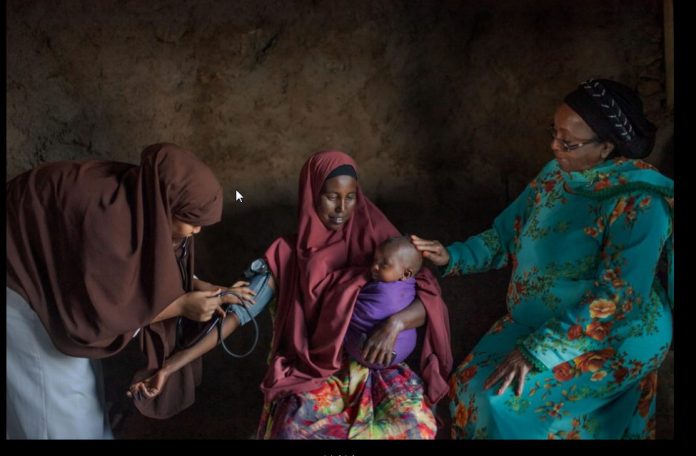In developing countries, maternal deaths are vastly more prevalent and an accepted fact of life. Health care infrastructure is often sparse or nonexistent. Quality prenatal care and pregnancy information can be limited. More than 9,000 miles from Los Angeles, the dusty highway between Somaliland’s capital, Hargeisa, and its third largest city, Borama, pierces the horizon like an arrow. The landscape is dotted sparsely with thorny acacia trees, and the sun beats down like a drum.

Venture off the paved surface, and the only roads are rocky and perilous, sure to scar the undercarriage of all but the sturdiest utility vehicle. It’s hard to imagine a woman in labor surviving the journey, in a vehicle or on foot, from a remote rural area to a health facility. Somaliland is a self-declared nation in the Horn of Africa, though it is widely viewed internationally as an autonomous region within Somalia
The main causes of maternal deaths in Somaliland are eclampsia (seizures or convulsions due to high blood pressure), hemorrhage, infection, and ruptured uterus. Other reasons include early or too many pregnancies, unassisted deliveries, and complications from female genital mutilation (FGM), a practice of removing external genitalia of girls and women in order to make them “pure” and suitable for marriage. The scarred tissue can narrow the birth canal, complicating childbirth. In Somaliland, consent for C-sections or any kind of lifesaving procedure, including a blood transfusion or surgery, has to be obtained from a male relative financially responsible for a woman’s health, such as her husband or a man from her husband’s side of the family.
In Somaliland, consent for C-sections or any kind of lifesaving procedure, including a blood transfusion or surgery, has to be obtained from a male relative financially responsible for a woman’s health, such as her husband or a man from her husband’s side of the family.
[pullquote]That is the landscape into which Edna Adan Ismail, the eldest of three children in a wealthy family, was born.[/pullquote]
Her father, Adan Ismail, was the most senior Somaliland health professional in the former British protectorate, which declared its independence in 1960. Of her mother’s five deliveries, one girl died during a forceps delivery in a hospital, a procedure that had almost killed Adan. Another died after being dropped on his head by a midwife.

Education traditionally was considered useless for girls, but Ismail encouraged it for all his children. He was furious upon returning home from a business trip when Adan was about eight years old to learn that her mother and grandmother had arranged for her to undergo FGM.
In 1954, at 17, Adan left Hargeisa to train as a nurse and midwife in London, England. Adan wanted to prevent girls and women from experiencing the trauma she endured during and after receiving “the cut,” as she calls FGM.
Now 81, Adan will tell you that her greatest achievement was not when she was Somaliland’s first female cabinet member. Her ultimate fulfillment comes from living at the Edna Adan University Hospital in Hargeisa as its on-site administrator. She rises every day before dawn and will not refuse a 9 p.m. meeting if it’s in service of her maternity hospital.
[pullquote]Adan says she begged, borrowed, and used her savings and pension to build the hospital.[/pullquote]

“The two main killers of pregnant women are poverty and ignorance,” Adan says, striking a regal pose from behind her desk. “A combination of those two kill more women than eclampsia or postpartum hemorrhage. So when you have a woman who’s illiterate, who’s poor—in Somaliland she’s also likely to be a nomad—she’s also lived a life where she’s never had any social justice. Superimpose on that a pregnancy that may have arrived when her body was not fully ready to receive a pregnancy. We delivered a woman here who was having baby number 21.”
Or she may be like the mother of the midwife and chief anesthetist at Edna Adan University Hospital, 27-year-old Hamda Omar Mohammed.
Omar’s mother, Samsam Mohammed, cooked for the construction crew as the hospital was being built in 2002, and Adan struck up an acquaintance. When Mohammed was not at her usual spot one day, Adan wondered why.
Mohammed was at home, bleeding nearly to death. A neighbor who had come to help had pulled on the umbilical cord when trying to deliver the placenta. The cord became detached, and Mohammed began to bleed. Mohammed’s husband ran to get help. Omar, then 11 and the eldest child of four, stayed behind to clean up the blood and look after her siblings. Adan arranged transportation to a government hospital, even donating her own blood to help save Mohammed.
Omar’s mother survived. Years later Adan persuaded that traumatized girl to become a midwife, one of the 938 she has helped train in Somaliland so far. “If I can help train a million midwives on the African continent, it will change the experience of childbirth. It will end the suffering for so many women and families.”

Source: National Geographic





























